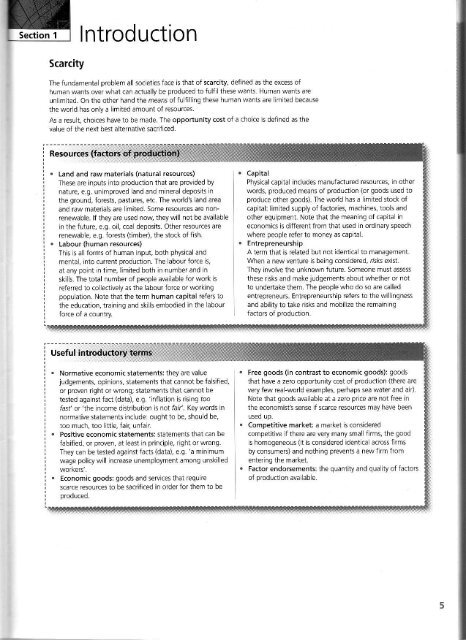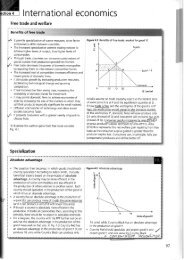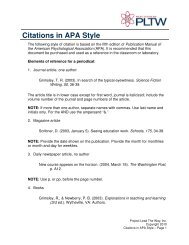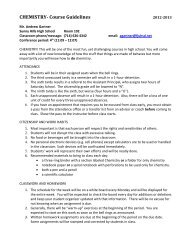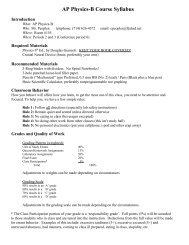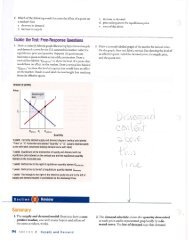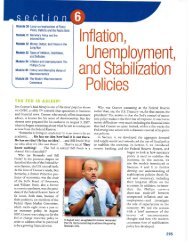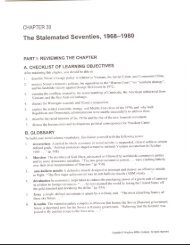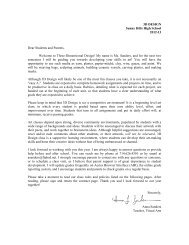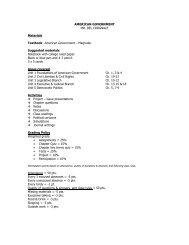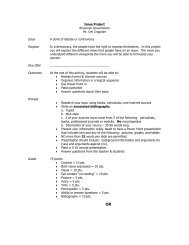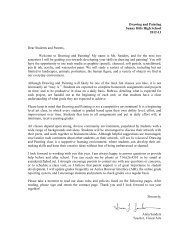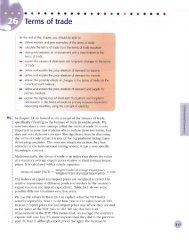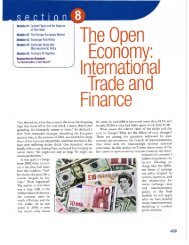IB Econ Intro Study Guide - Sunny Hills High School
IB Econ Intro Study Guide - Sunny Hills High School
IB Econ Intro Study Guide - Sunny Hills High School
You also want an ePaper? Increase the reach of your titles
YUMPU automatically turns print PDFs into web optimized ePapers that Google loves.
Scarcity<br />
lntroduction<br />
The fu ndarnentd I prob enr allsoc et es face is that of scarcity, defined as the excess of<br />
human wanh over what can actually be produced to fulf lthese wants Human wants are<br />
un m ted. On the other hand the nleari of fu fil ng these human wants are mlt€d becalrse<br />
the word has on y a inrted amount of resources.<br />
As a resu t, choces have to be made. The opportunity €ost of a choice G defined as the<br />
value ol the next best alternative sacll ced.<br />
Resources<br />
Land and raw materials {natural resoutcet<br />
These are inputs into production that are prov ded by<br />
'dr . e e.g. ,r . p'ov"d ard r,rd - e'dld€po( . ^<br />
the ground, forests, pastures, elc The world3 and area<br />
and raw materials are mited. Some r€sources are nonrenewable.<br />
lf they.re used now, theywill not be availab e<br />
n the fuiure, e.9 oil, coa deposits. Other reso!rces are<br />
renewab e, e.q. foresrs (timber), rhe stock of fish<br />
Labour (human resources)<br />
This s al foms of hurnan nput, both physical and<br />
menta, into.urrent producton. The aboLrr force s,<br />
at any po nt n t me, I mited both ln number and n<br />
skl s The total nlrmber of peop e ava abe for work s<br />
'" p,eo .o.o ".<br />
\ey d.-'" o.eo<br />
"oo.r,<br />
popu<br />
^ortirs<br />
dton. Note thatthe tem human capital refers to<br />
the education, tra nlng and sk ls €rnbodied in the labour<br />
useful<br />
Normative economic 5tatements:they ar€ value<br />
jldgements, opinions, statements that cannot be fasif€d,<br />
or proven rght or wronq' statements that cannot be<br />
rp.tFodgo r.. dL.'daLar Fq<br />
"rt.ioli)r,no,o,<br />
fasf or th€ ncome d nibuton is not fal. Key words n<br />
normative statements inc ude: ought to be, shou d be,<br />
too much, too tte, fair, unfa r.<br />
Positive economic statemenls: stat€m€nts that can be<br />
fa sifi€d, or proven, at e.st npdncip€,rghtorwrong<br />
Th€y can be tesled .ga nst facts (data), €.9 'a m n mum<br />
waq€ policyw ll n.reaEe unemploym€nt among unskiled<br />
<strong>Econ</strong>omic goods:goods and servces that requ re<br />
scarce resources to be sacrificed in orderfor them 10 b€<br />
. capital<br />
Physicalcapta incud€s manlfactured r€sources, n other<br />
words, prodlrced means of prodLrctlon (or goods us€d to<br />
produce oth€r goods). The world has a m ted stock C)l<br />
cap tal: im ted suppy offactoies, machin€s, tools and<br />
other equ pm€nt Note that the mean ng of captd in<br />
economics is dlfferent from that used n ord nary sp€ech<br />
where people refer to fioney as cap ta.<br />
. Entrepreneu|ship<br />
A t€rm that is related blt not ident ca to management.<br />
When a newv€nture s being cons der€d, tsks exist<br />
lh€/ rr o\" rLr-<br />
.o-aorp r r. dsso\<br />
these rsks and makejudqements aboutwhether or not<br />
to undertake them. The people who do so are called<br />
entrepreneurs. Entrepreneurship rcfers to the wil ngness<br />
and abilityto take risks and mobilze the r€rnain nq<br />
factols of prodrrction.<br />
Free goods (in contrast to economic goods): goods<br />
that have a zero oppoiruniiy cost of prodLrcton (ther€ ar€<br />
veryfew rca -world examples, perhaps sea watef and alr)<br />
No- t".Sood,"/" ab"" r"a.eno f-.r<br />
".eop<br />
the economist3 sense l scarce resources may have been<br />
Competitive market:a market rs considered<br />
competitlve f th€re are v€ry nrany smal firms, the good<br />
s homogeneous ( i is consid€red ident ca acrcss frrms<br />
by consumert and noth nq prevents a new f rm lrom<br />
Factor endorsements:the quantity and qua ity of factors<br />
of productlon ava ab€.
I<br />
i.,.<br />
E<br />
i<br />
E<br />
The fundamental questions of economics<br />
<strong>Econ</strong>omic : -::.-:<br />
lj-.r.]ti.iil<br />
scarcty n€cesstates choce. As a resu t, a lsocieties,<br />
independently of the r eve ol econoril c deveopment or<br />
the economic synem adopted, face and nrLrsi answer the<br />
fo owing three quest ons:<br />
. What (i.e. which Soods)w be prodlced and n what<br />
. How wi each good be produced (us ng, say, a labouF<br />
inlensive or capita intensive tech no ogy)?<br />
. Fofwhom? {How w incorn€ be distdbuted?)<br />
How a society goes about answer ng th€se qu€nons<br />
d"oeldr o- .le elo orr' syter ' . ar<br />
"dopl -.o o ni<br />
sysrem can be broddly def ned as the nst turiona fra mework<br />
wthln which economic act vity takes place. lt s easy to<br />
distingu sh 1wo exveme cases but n ihe rea world the<br />
*'1,<br />
..]l<br />
A producion posslbilites frontier {PPF)refe6 to an<br />
econonry endowed w th a f xed a mounl of resources, s<br />
characterzed by a giv€n level of tech no oqy as wellas<br />
some nnitutional framework, and prodLrcing only two<br />
goods. lt shows for ev€ry amo!nt produced of good X,<br />
the max mum amount of good Y that it can prodLrce,<br />
f il fu y uti zes its im ted resources us ng the available<br />
technology. For examp e, ref€n ng to Fig. 1.1, lthe<br />
economy decidesto produce Xl units of good Xthen it<br />
can produce arthe most Y1 unlts of good Y assum ng<br />
ihat it fu y utihz€s ts im ted rcsources with th€ ava ab e<br />
technology. A PPF is a technolog cal relai onsh p and it<br />
prov des us no information about choces. lt shows what<br />
an econorny can do, not what t chooses to do.<br />
The niere exist€nce of a PPF ref ects scarcity: an economy<br />
s constra ned in production to only some comb nations<br />
of output. lt fo ows that po nts oulslde a PPF (such<br />
as po nt A in Fig I 1)denole output comb naton:<br />
of the two goods that are unattainab e g ven the<br />
amount of resources available and the present evel<br />
of technoogy. Po nts lrslde the PPF (such as poinr B<br />
1-g. l d.no.edddndbeb- reff.ier o,rrpL.<br />
combinatons in the sense that resources are not {uly<br />
uti zed, e.g. unemployment s pr€sent. Po nts on the PPF<br />
(such as points F and H)denote attainab€ and €fficient<br />
combinatons as no waste o{ scarce r€sources s present<br />
and it s not possibe to produce more of one good<br />
witholt sacll cinq some of the other<br />
The negatve slope of the PPF ref ects thai in orderto<br />
produce more of one qood, resources have to be diverted<br />
dwayfrom the prodLrction ofthe other good sothat less<br />
ol the atter can ,ow be at rro5r produced: there is th us<br />
an 'opportun ty cost' nvolved in producing an extra unit<br />
ol a good. lt s the arnount ofthe other good that hasto<br />
B€cause scarce resolrrces are rot€qua ywe su ted ior<br />
the prcduction of a goods (in otherwords, because<br />
varatons are very many. Countries h storica ly develop<br />
the r own set of institutons that answer these questons.<br />
The c!ffent Chin€se experence s a case n point The two<br />
extremes are market €conorn es and comrnand econorn es,<br />
with mixed economies being in between.<br />
. A market economy s an economywhere households<br />
and firms each act ng n ihe I own sef-interest determ ne<br />
answers to the three quenions abov€ throLrqh their<br />
nteraction in markets.<br />
. A command economy s on€ where the state prcvides<br />
. A mixed e€onomy is one where both m.rkets and the<br />
nate are responsible for the answers.<br />
figurer,t The production possibilitiesfrontier<br />
x2 x3 x4<br />
Unitsofg@dY<br />
resolrces tend 10 be specia zed)the PPF s bowed<br />
towards the or qln. The slope (the tangent at €ach point,<br />
, r.I as dr oo,tr, I and H\ becoreg. eppe, d,ld tFepFr.<br />
reiecting that the opportunity cost of producing more<br />
and more of good X lthe qood on the horzonta axt s<br />
lncreasing n Fg. 1.1, the oppo(un ty cost of produc ng<br />
X]X2 extra units of good X is the sacr f ce of Y1Y2 un t5<br />
of good Y Th€ oppo(un ty con of X3X4 extra un ts ofX<br />
(where X3X4 = X1X2) is thls b qq€r and equa to Y3Y4<br />
units ot good Y Th s s the law of ncreaslng cons. The<br />
typicalshape of ihe production poss bilties curve shows<br />
that t b€comes more and more conly to produce ever<br />
increasing quanijr es of a good as resources tend to be<br />
specalzed. lf, on the other hand, resources were perlecty<br />
substiiutabe ihen the PPF would be a negatvey soped<br />
nfa ght ine refecting constant opportunity costs.
Growth<br />
Growth of an economy can be ilustrated through an<br />
outward sh ft of the PPF. We can d sting! sh between<br />
Actual growth: th s ref€6 to an increas€ n the amounts<br />
of good5 and servces actua yprodLrced. trelerstoan<br />
ncrease if tota output. lt is lunrakd wth a movenreni<br />
from a po nt ins de the PPF to another point towdrds lhe<br />
northeanwith more of at least one good. Rea GDP (the<br />
terrn used ater to refer to th e total output produced n an<br />
economyl nas Incr€as€o.<br />
PotentialgroMh:the terrn reiers to the rdte at whrdr<br />
a country's ecorlomy could grow if all h resources werc<br />
fu y empoyed. Potentalgrowth is lustrated wth an<br />
oltwad shift of the PPF.<br />
. In Fig.l.2a, actua groMh i5 llLrstrated as a movement<br />
from pointAl to pointA2 wherc output m x A1 contains<br />
X] and Y1 un ts ofthe two qoods whl€ output mlx Az<br />
coniains more ofborh goods 1X2 units ot good X and<br />
Y2 lnits of good Y). Actual groMh can thus be ach eved<br />
by better uti zalon of exsting resources. Fgure 1.2b<br />
lunrat€s potentia growth as the producton possib lites<br />
of the economy have ncreased (expanded) from FF'to<br />
HH'. Th s economy s now able to produce comb nations<br />
of outputthat were in tia ly unatta nable. Potentia<br />
growth is the resull of an ncrcas€ in resolrrc€s (mor€<br />
labour and more captal)and/or better technology being<br />
ava abe (wh ch may a so rcferto improved innitltiont.<br />
More sp€cfcally groMh occurs if ther€ s an ifcrease n:<br />
. Land {natural resources): e g. if new metal d€posilv<br />
m nerals are discovered.<br />
. Labour: labour can ;ncrease if: popu ation ncreases<br />
(throLrgh a natura ncrease orthrough migration); fth€re<br />
rs a. n.?aa o peop . or ro \irg doe<br />
if there s an increas€ n the particpalon tai€ ofsonre<br />
population grcup (e.g morewomen decidetojon the<br />
abour force, or more teenagers).<br />
Human capital: th€ skil s, edlcat on and training<br />
embodied in the abour force of an econorny.<br />
Capital: if the stock of capta (i.e. of machines, toos,<br />
equ pment, build ngs, etc.) increases. An increase n the<br />
stock oJ capital s defned as nvestment.<br />
Technoogy and nsttutions imprcve (as the abilty of a I<br />
faciors to produc€ w ll be enhanc€d)<br />
Figure 1.2 (a) Actualgrowth (b) potenti6lgroMh<br />
Tips<br />
5<br />
'E<br />
Make sure thatthe PPF you drawtouches the two axes<br />
and is no1'foat nq'in rn d-a r Draw it bowed (concave)<br />
towards the oigin un ess you are us ng it to lunrat€<br />
constant opportLrnity costs. Ako note that the axes may<br />
be labe ed'consumption goods' and 'cap tal goodt in<br />
order to lllrstrate the oppoirunity cost ol invenrnent. In<br />
this case, the opportunity con ol prodlcing more capitaL<br />
goods (i e. the opportun ty cost of nvestment) s the<br />
sacrfice of present eves of consumpton


